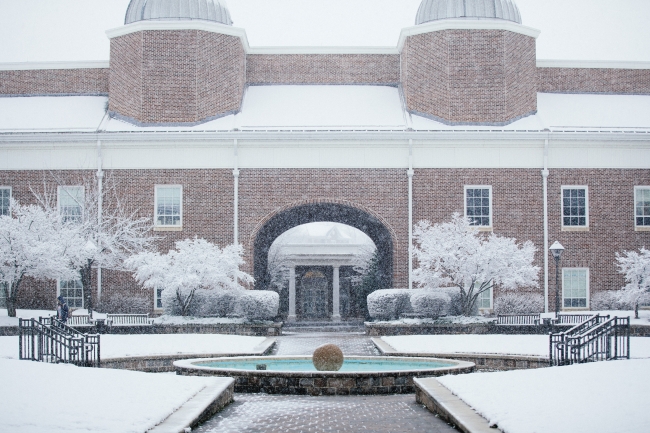You have /5 articles left.
Sign up for a free account or log in.

The College of New Jersey closed for snow Wednesday and half of Thursday.
Lauren H. Adams, the College of New Jersey
As the fourth snowstorm in three weeks worked its way up the East Coast Wednesday, the University of Massachusetts Dartmouth planned to close its campus at 6 p.m. Yet administrators considered themselves lucky because of the timing of the storms.
“They've been on weekends and spring break,” said John Hoey, vice chancellor for public affairs. “It's made all the other planning around it a lot easier.”
The timing worked out again. On Thursday morning, the 8,600-student university opened for business as usual after the storm dropped less snow in the region than initially forecast.
Colleges elsewhere along the coast weren’t quite as lucky. The College of New Jersey, for instance, closed Wednesday and only reopened at noon Thursday after Ewing, N.J., was hit with about eight inches of snow. Leaders there say they could spend more than originally expected on snow cleanup costs this year.
Budgeting for costs tied to the weather is an imprecise science, but it’s one colleges have to undertake. There’s been no shortage of potentially costly weather events in the last year, whether you’re counting snow, rain or wildfire. And some predict extreme weather is likely to increase because of climate change.
Colleges don’t necessarily build their budgets with an eye toward climate science, though. Many believe contingency funds are always a good mechanism to build into budgets, because they can save leaders from having to scramble to find money for unexpected repairs or cleanup after an intense storm.
Endicott College, on the coast of Massachusetts, has increased its contingency budget more than fourfold in the last five years, to over $1 million. The move looks prescient right now. Storms earlier this year damaged four sections of the college’s seawall, which runs almost a quarter of a mile, according to its president, Richard Wylie.
“You could just hear the wall crumbling,” he said. “My house is right near the seawall, and I’ve got to tell you, I thought lightning was coming every minute. It was loud, and you just knew things were caving in.”
Wylie estimates damage will likely total nearly $1 million. But the price tag could end up being more by the time damage is fully assessed and repairs are finished.
The 4,800-student college budgeted about $2.5 million for campus maintenance this year -- not insignificant in a $180 million expense budget. The college planned for some seawall maintenance, but not necessarily the amount that will now be required. So without contingency funding, the seawall damage could have been a significant source of budgetary pressure.
Trustees might have been worried about having to borrow to make repairs, Wylie said. But the college has been preparing for contingencies. The budgeting practices help assure trustees and parents, Wylie said.
“I have to be able to assure parents that when you have a catastrophe like this, the cost of education is not going to go up to cover it,” he said. “From my perspective, the goal here is to be prepared for these things. They’re going to happen.”
Even for colleges that haven’t suffered substantial physical plant damage, snow removal costs can be a significant budgetary variable.
The College of New Jersey expects to see a large impact from northeasters on this year’s budget, according to Luke Sacks, head media relations officer. Emergency personnel worked for more than 26 hours to allow the college to open at noon Thursday. The college is no stranger to extreme weather, having closed for five days after Hurricane Sandy. It hasn’t changed its budget processes in recent years, although budgets sometimes require supplemental funding for equipment replacement, materials and labor.
Some say the greatest weather-related costs aren’t from paying workers to clear campus. They’re from suspending operations and losing staffing time.
A $100 million campus with 80 percent of its costs coming from personnel loses a little more than $300,000 for a day of closure, according to Guilbert Brown, acting assistant vice chancellor at the Pennsylvania State System of Higher Education.
“In our state system today, at least four institutions are closed due to Winter Storm Toby, at a total cost in the range of $1.5-2 million just for salaries,” he said via email Wednesday. “There are additional costs related to snow removal, freeze/thaw and building damages, and lost revenues for food and other sales.”
It’s hard to control for costs related to lost time. Telecommuting is sometimes an option, but it’s not possible or useful for every situation.
Dean College in Franklin, Mass., allows a “good-sized” budget to cover eventualities, according to Brian Kelly, assistant vice president for capital planning and facilities. This winter has actually been less difficult to manage in comparison to other winters for the college, which has almost 1,000 students on campus, he said via email.
“The only thing unusual about this year’s weather is the timing,” he said. “Typically, major snowstorms occur earlier in the season, but as a small institution, we have the benefit of being agile and responsive to changes.”
The timing of storms could end up putting the most pressure on scheduling for athletics and academics.
“It's definitely had an absolute out-of-pocket impact,” said Richard Doherty, president of the Association of Independent Colleges and Universities in Massachusetts. “It's also making it very hard to have everyone finish up all their classes. There have been a number of two-day closures at schools with each of these storms, and there's not a lot of time left in the semester to be making up and figuring out how to get all the material in before exams start.”
To the extent they can, colleges still try to control weather-related costs. The University of Massachusetts Dartmouth has been lucky with the timing of storms this year, but it’s also worked to slash costs after spending about $900,000 on snow removal last year.
It bought salt and other road-treating materials outside the winter storm season, when the price was lower, and returned formerly outsourced plowing duties to its own workers. Leaders now project spending about $400,000 on snow removal this year, even with the recent succession of storms.
Campuses are ultimately at Mother Nature’s mercy when it comes to dodging weather-related costs and scheduling headaches, acknowledged Hoey, the university’s vice chancellor for public affairs.
“This is a little bit of an outlier this year,” he said. “It's about how many other storms you've had.”
Some trends point to more extreme weather around the globe. This year’s snowy March in the Northeast follows a 2017 that was the most expensive year on record for severe weather and climate events, according to the World Meteorological Organization's annual Statement on State of the Global Climate, which was released Thursday.
The beginning of 2018 started where 2017 left off, said WMO secretary-general Petteri Taalas. In a statement, he referenced densely populated areas in the northern hemisphere being “gripped by bitter cold and damaging winter storms.”
The WMO pointed to atmospheric concentrations of carbon dioxide that are far higher than at any time in modern history, predicting a future with more extremes in weather, climate and water.
The National Centers for Environmental Information have estimated total losses in the United States from Hurricanes Harvey, Irma and Maria at $265 billion. Some of those costs were shouldered by colleges and universities.
Hurricane Harvey caused numerous colleges in Texas to shut down, brought flooding to campuses and forced student evacuations. The University of Houston system currently estimates damage costs of $53 million, although that could still change.
When Hurricanes Maria and Irma caused massive damage in the Caribbean, they did not spare universities, damaging buildings, straining budgets and displacing students.
In a more recent case of severe weather, Jacksonville State University has closed its campus through April 2 because of tornado damage sustained Monday. Officials have said it could take a week or more to fully evaluate building conditions and draw up contingency plans for classrooms and student housing.
In December, wildfires in Southern California prompted campus closures and canceled classes. The University of California system has insurance that covers many weather events like wildfires. But campuses also budget for emergency supplies, according to a system spokeswoman. Generally, campuses take an “all hazards” approach to emergency preparedness, getting ready for everything from earthquakes to floods, she said.








